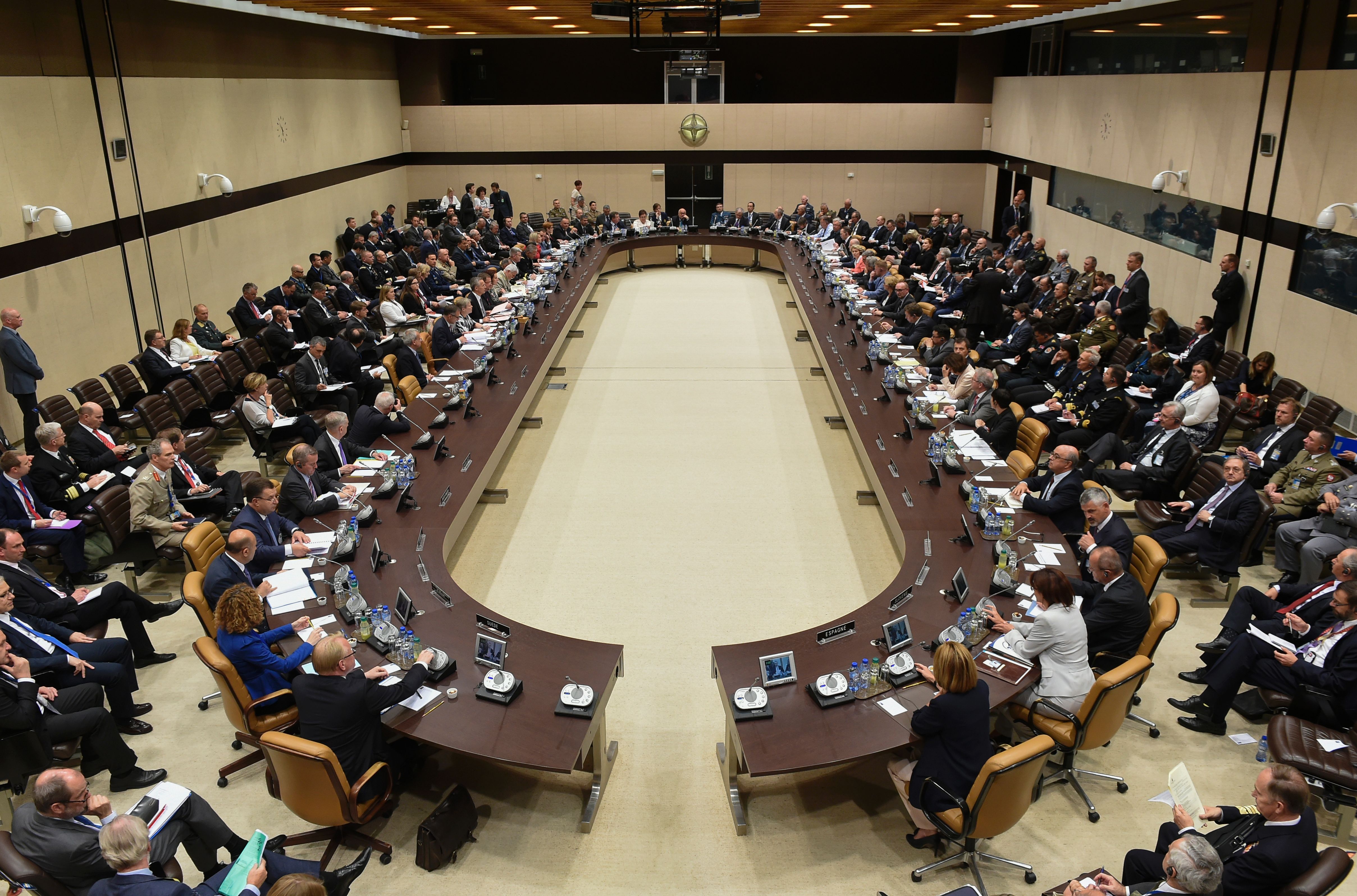
If European Union powers ditch the alliance in favor of mounting an EU defense force to supersede NATO, U.S. outlays for NATO that look expensive now will seem like a bargain.
The North Atlantic Treaty Organization (NATO) is becoming a grotesque behemoth, a “Franken-NATO” of sorts, with a body mostly comprised of the European states it was created to defend, a head that is distinctly American, and a lot of confusion about its purpose. At NATO’s inception in 1949, its original 12 member-nations had a clear, common goal: deter Soviet aggression. And yet, NATO’s most dramatic expansions have occurred since the Soviet Union’s collapse. On June 7, 2017, Montenegro joined as NATO’s 29th member. Such growth comes at a price, including internal tensions about the alliance’s future, and external temptations concerning other security relationships, which may yet divide U.S. and allied interests to a breaking point.
Complicating things is the fact that not all NATO members agree on a common threat. For example, some (mostly Eastern European and Baltic) allies fear Russia, while others such as Germany and France seem more concerned about an influx of Syrian war refugees, multicultural terrorism, and other threats to stability and security. Amidst all this, Americans complain that the U.S.’s European allies are not paying their “fair share” for defense; yet, pressuring them to do so could cost the U.S. more than its strategic interests can bear. If European Union (EU) powers ditch the alliance in favor of mounting an EU defense force to supersede NATO (thereby reducing U.S. influence), U.S. outlays for NATO that look expensive now will seem like a bargain. Such a force seems increasingly likely.
The same day Montenegro’s flag went up at NATO Headquarters, the European Commission released a Reflection Paper on the Future of European Defence. It proposed three levels of ambition for the future of EU security. At its heart lay a goal of European “strategic autonomy.” Though a U.S.-led NATO has encouraged greater EU capabilities as helpful to itself (they share 22 states in common), the question is how far the EU will go if the proposal is adopted. The answer may have important implications for U.S. security interests in Europe.
Two weeks before NATO pledged itself to defend Montenegro, U.S. President Donald Trump criticized a majority of its allies for not living up to their existing obligations. He told them 23 were still “not paying what they should…for…defense,” and implied the U.S. might hedge on its treaty obligations unless they did. Germany and France, chronic under-payers, balked. Three days later, German Chancellor Angela Merkel announced, “the times when [Europeans] could fully rely on others have passed.” She urged Europe to “take [its collective] fate into [its] own hands.” French President Emanuel Macron agreed, having already urged her to join him on a path toward greater Franco-German defense cooperation.
The EU’s thus-far toothless and under-funded European Defence Agency theoretically prioritizes and rationalizes the EU force. In the past, such a force has been downplayed, not only for its lack of resources, but also for the shortage of political will to develop it. The UK threw a wrench into any mechanisms it considered redundant with NATO. Given the UK’s vote to leave the EU (“Brexit”), that will now change. Franco-German distaste for President Trump’s “America First” mantra and friction among remaining allies could seed a storm cloud which dampens confidence in NATO’s future, especially because the EU finally seems ready to make it rain.
The defense paper’s timing may reflect the Commission’s view that current trans-Atlantic tensions present a golden opportunity to promote the European Defense Agency and its call for joint acquisition projects that keep the wealth at home by employing only European contractors. The paper outlines several different levels of commitment to an EU-wide collective defense. In its most ambitious vision, EU defenses would be integrated to a point of severely-diminished national sovereignty for its participants, making them dependent on a supranational EU agency for their protection.
By treaty and by arrangement with NATO, existing EU forces are only meant to complement — not parallel — the Alliance’s. Under the Berlin Plus Agreement, the EU is to handle humanitarian relief, peacekeeping, and crisis response, not combat missions. Though the EU proposal is careful to say any new ambitions would not rival NATO’s functions, this remains to be seen, especially since the effects of the scheme would not be felt until about 2035. Much could happen before then, judging from the rate of change since 2014.
When Russia annexed Crimea in 2014, one might have expected that this resurgence of Russian expansionism would give greater coherence to NATO. Indeed, it gave European defense spending a bump no amount of U.S. pleading had. Without question, recent events in Ukraine strengthened NATO’s European security mandate. However, other troubling incidents involving NATO allies have challenged European political cooperation, on which much of NATO’s military coherence depends. Germany, for example, strongly objected to U.S. sanctions which hindered Russia’s participation in Nord Stream 2, a joint pipeline project to carry Russian gas to the EU market. Meanwhile, Poland, which backs a hard line toward Russia, was threatened with suspension of its EU voting rights over changes to its judiciary – this, on top of Brussels’ upset over Poland’s (and Hungary, Slovakia, and the Czech Republic’s) reluctance to accept non-European refugees. Hungary stands with Poland on refugees, but sympathizes with Russia on other issues, as do Slovakia, Greece, and Turkey. Turkey, long ago “friend-zoned” by the EU, is having relationship problems with NATO too. It recently snubbed alliance interoperability goals by buying a Russian missile defense system, and Turkish President Recep Erdogan’s so-called “creeping authoritarianism,” contrasts with the values that NATO members are pledged to uphold. The sutures holding NATO’s members together in Europe are under strain. The U.S.’s de facto leadership of NATO may not be enough to keep them from rupturing.
The European Commission, by contrast, holds significant de jure power over its members. Having a supranational, EU-led military force would only increase this. While such a force would lack the strategic gifts of Turkey, the U.S., and the UK, it could retain forces from 21 other NATO members (including nuclear France). Those states’ NATO insights could help the EU improve its command structure and emulate six NATO competencies: consultation, command, communication, planning, training, and fighting. The EU’s current NATO partnership already affords it excellent “gazing rights,” to study the NATO giant up close and to learn from regular contact.
NATO remains tremendously important to U.S. and European security. The U.S. and its European allies must not let family member squabbles undermine the security of the home they have built and shared for almost 70 years.
Another boon to an EU-led force’s gradual development is found in the Union’s Common Security and Defense Policy. Articles 42 through 46 give members the option of undertaking “permanent structured coordination” with each other, to pool and share defense resources multilaterally. Such integration allows them to reach higher levels of capacity together than they could alone. Other models which states might emulate include those of Sweden and Finland, which both have commendable innate capacities. Both are EU members which coordinate with, but do not belong to, NATO. For various reasons, they prefer to retain their autonomy in defense matters, which may offer them more influence within the alliance than even some members enjoy.
While current EU agreements imply non-interference with NATO operations, their language is vague, and voting on defense development issues is by qualified majority (bigger states get more votes). After Brexit, the UK will lose some influence. It could threaten to withdraw from its deeply-enmeshed cooperation with France on nuclear deterrence and missile defense, but is unlikely to, given the cost savings integration yields. Therefore, power could be even more concentrated by those members that now seem eager to push for a strong, European-led defense force. To shepherd it along, some are calling for the appointment of a deputy for the Commission’s High Representative for Foreign Affairs and Security Policy. Incumbent Federica Mogherini holds a combined foreign affairs and defense portfolio. A deputy would handle defense matters exclusively and raise their profile.
An EU force cut loose from U.S. influence increases the risk that European and American security interests will further diverge. As much as the U.S. has been burdened by compensating for NATO allies’ shortfalls in defense spending, it would be strained much more by an EU force that retreated from security missions of interest to the United States. Russia, China, and Iran would be emboldened by any European drift from the U.S.
Such a drift is also against the U.S.’s economic interests. “Following the money” is a good way to figure out where Europe’s long-term interests lie. Though the EU is the United States’ largest trading partner, past performance is no guarantee of future results. The U.S. has no guarantee of continued strong European demand for its goods and services. A U.S. without much influence in Europe may have little choice but to accept a much-diminished economic position there, as other trading partners (especially India and China) compete for a greater market share.
If the U.S. wants to perpetuate and strengthen NATO as Europe’s security apparatus of tomorrow, it must not spark EU defense ambitions to life by supporting further NATO enlargements or by criticizing the NATO it has, at the expense of the NATO it wants. Though past enlargements may have strengthened the alliance, future ones could weaken it. Not only could more voters make NATO consensus-building harder, but also Russia’s security dilemma could deepen and make conflict with NATO more likely, not less so. Despite being NATO’s “indispensable” member, the U.S. cannot afford to ignore other members’ economic and security concerns, or to turn NATO into an ironic catalyst for their insecurity, by being insensitive to their national interests.
Scholar Michael O’Hanlon recently proposed that NATO suspend adding new members, including Georgia and Ukraine, which have already undertaken Membership Action Plans. He recommends a zone of neutral states between NATO and Russia, to calm Russia’s fears of encroachment and ease its tensions with NATO. The U.S. hinted at a different course during Vice President Michael Pence’s recent visit to Georgia, where he supported its NATO aspirations. He also reaffirmed Ukraine’s “territorial integrity,” though Russia had annexed Crimea and Ukraine’s eastern provinces’ were at war.
While there is merit to not shrinking from bad actors such as Russia’s President, Vladimir Putin, it must be understood that from a realpolitik perspective, the longest possible view of any U.S. grand strategy should include the pursuit of good Euro-Atlantic relations with Russia. Many allies agree; yet, U.S. support for sanctions on Russia and for further NATO enlargement can only complicate Europeans’ already-fraught relations with Russia.
Though it seems improbable right now, the “house that NATO built” may yet fall, if tremors from divergent U.S. and inter-European interests slowly rattle it to pieces. The political (and ultimately economic) costs of fracturing the “monster” alliance may prove higher than the U.S.’s financial burdens to keep it viable. The U.S. should not assume that its past assistance to Europe will perpetuate allied loyalties. It must lead with its money, with a long view toward what current EU murmurings might mean for future security arrangements. It must also mitigate allied perceptions that the U.S. always gets its way in NATO, by letting others at the table order to their own tastes, given that they do help split the bill.
NATO remains tremendously important to U.S. and European security. The U.S. and its European allies must not let family member squabbles undermine the security of the home they have built and shared for almost 70 years. Given NATO’s origins in the defense of a free Europe, it is ironic that NATO’s first invocation of its treaty’s Article 5 resulted from the 9/11 attacks on the United States. (Article 5 holds that an attack on one member shall be considered an attack on all.) Accordingly, NATO’s European members deployed thousands of troops to Afghanistan and elsewhere. This was a testament to the power of the alliance and its members’ collective devotion to the principles which inspired NATO’s creation.
To stay unified, NATO must focus on rebuilding a strong sense of common purpose and contain its expansionist ambitions. Even if the EU does not opt for a full-fledged European-led defense force, the U.S. should show more concern for its allies’ political sensitivities concerning other powers. In short, it must adopt a savvier approach to persuading its allies to remain within NATO’s security architecture or risk giving life to a new “monster,” one in the form of a truly robust European-led defense force that may yet dissect the alliance.
Mary Foster is an adjunct professor at the U.S. Army War College. The views in this article are those of the author and do not necessarily reflect those of the U.S. Army War College, U.S. Army, or Department of Defense.
Photo: 2017 NATO Defence Council meeting at the NATO Headquarters in Brussels.
Photo Credit: JOHN THYS/AFP/Getty Images




